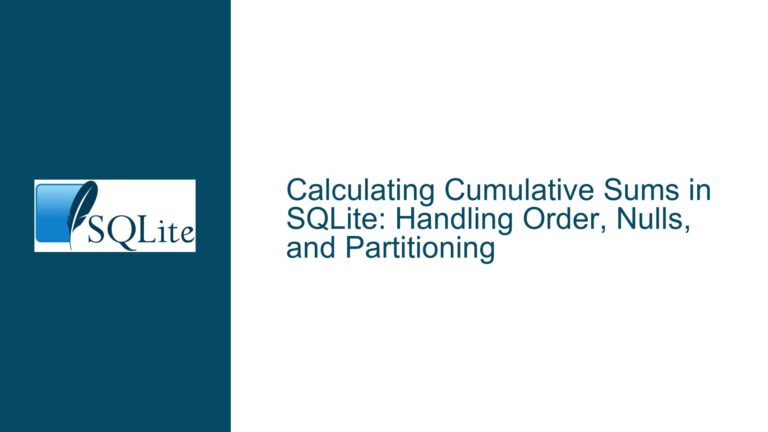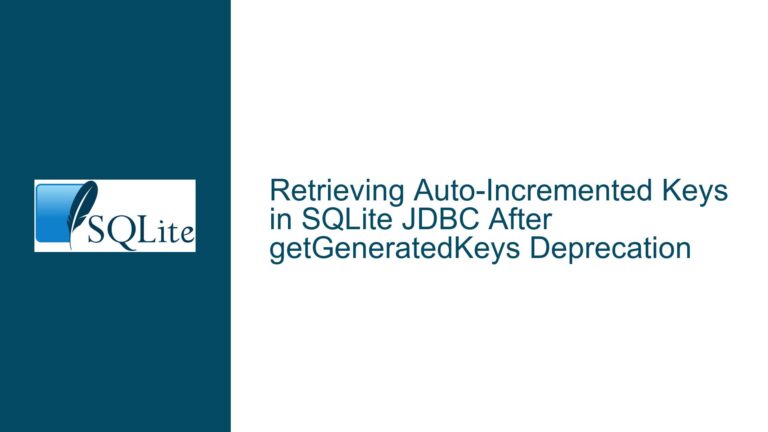SQLite Table-Valued Functions: Joining with Dynamic Constraints
Joining Table-Valued Functions with Dynamic Constraints in SQLite
When working with SQLite, one of the more advanced features is the ability to create and use table-valued functions (TVFs). These functions allow you to return a set of rows that can be treated as a table within a query. However, when attempting to join these table-valued functions with dynamic constraints, developers often encounter challenges. This post will delve into the intricacies of joining table-valued functions, the common pitfalls, and how to resolve them.
Issue Overview: Dynamic Constraints in Table-Valued Functions
Table-valued functions in SQLite are powerful tools that can be used to encapsulate complex logic and return a set of rows that can be queried like a regular table. However, when you attempt to join two table-valued functions where one function’s output is used as a dynamic constraint for the other, issues can arise. Specifically, the problem occurs when the second table-valued function does not recognize the dynamic constraint passed from the first function.
Consider the following scenario: You have two table-valued functions, github_org_repos('ORG_NAME') and github_pull_requests('ORG_NAME', 'REPO_NAME'). The goal is to join these two functions such that the repo_name from the result set of github_org_repos is used as a parameter for github_pull_requests. The desired query might look something like this:
SELECT *
FROM github_org_repos('ORG') repo
JOIN github_pull_requests('ORG') pr
ON pr.repo_name = repo.name;
In this query, repo.name from github_org_repos is intended to be used as the REPO_NAME parameter in github_pull_requests. However, this query often fails because the github_pull_requests function does not recognize repo.name as a valid parameter.
Possible Causes: Misalignment in Parameter Passing and Constraint Application
The core issue lies in how SQLite handles the passing of parameters and the application of constraints in table-valued functions. There are several potential causes for this misalignment:
Parameter Binding Order: SQLite may not be binding the parameters in the expected order. When you pass a dynamic constraint from one table-valued function to another, SQLite might not correctly interpret the relationship between the two functions. This can lead to the second function not recognizing the parameter passed from the first function.
Virtual Table Implementation: The implementation of the virtual table that underlies the table-valued function may not be designed to handle dynamic constraints properly. If the virtual table does not support the passing of parameters from another table-valued function, the join operation will fail.
Join Order and Optimization: SQLite’s query optimizer may not be handling the join order correctly. If the optimizer decides to execute the
github_pull_requestsfunction before thegithub_org_reposfunction, the dynamic constraint fromgithub_org_reposwill not be available whengithub_pull_requestsis executed.Error Handling in Virtual Table Implementation: The virtual table implementation may not be handling errors or unexpected inputs gracefully. If the virtual table does not have proper error handling for cases where a parameter is not provided or is invalid, it may fail silently or produce incorrect results.
Troubleshooting Steps, Solutions & Fixes: Ensuring Proper Parameter Passing and Constraint Application
To resolve the issue of joining table-valued functions with dynamic constraints, you need to ensure that the parameters are passed correctly and that the virtual table implementation supports dynamic constraints. Here are the steps to troubleshoot and fix the problem:
Verify Virtual Table Implementation: The first step is to ensure that the virtual table implementation supports dynamic constraints. Review the code that implements the virtual table, particularly the
xFiltermethod, which is responsible for applying constraints. Ensure that thexFiltermethod can handle dynamic constraints passed from another table-valued function.Explicit Parameter Passing: Instead of relying on SQLite to infer the relationship between the two table-valued functions, explicitly pass the parameters. For example, you can rewrite the query as follows:
SELECT * FROM github_org_repos('ORG') repo JOIN github_pull_requests('ORG', repo.name) pr;In this query, the
repo.nameis explicitly passed as the second parameter togithub_pull_requests. This ensures that the parameter is correctly bound and recognized by the second function.Use CROSS JOIN to Control Join Order: If the issue is related to the join order, you can use a
CROSS JOINto force SQLite to execute thegithub_org_reposfunction before thegithub_pull_requestsfunction. This ensures that the dynamic constraint fromgithub_org_reposis available whengithub_pull_requestsis executed. The query would look like this:SELECT * FROM github_org_repos('ORG') repo CROSS JOIN github_pull_requests('ORG', repo.name) pr;Check for Errors in Virtual Table Implementation: If the virtual table implementation is not handling errors or unexpected inputs gracefully, you may need to add additional error handling. Ensure that the virtual table can handle cases where a parameter is not provided or is invalid. This may involve adding checks in the
xFiltermethod to validate the parameters before applying them.Test with Static Parameters: Before attempting to use dynamic constraints, test the table-valued functions with static parameters to ensure that they are working correctly. For example, test
github_org_repos('ORG')andgithub_pull_requests('ORG', 'REPO_NAME')separately to verify that they return the expected results. Once you have confirmed that the functions work with static parameters, you can proceed to test with dynamic constraints.Review SQLite Documentation: SQLite’s documentation on virtual tables and table-valued functions provides valuable insights into how these features are intended to work. Review the documentation to ensure that your implementation aligns with SQLite’s design principles. Pay particular attention to the sections on parameter passing and constraint application.
Consult the SQLite Community: If you are still encountering issues, consider reaching out to the SQLite community for assistance. The SQLite forum is a valuable resource where you can ask questions and get feedback from experienced developers. Be sure to provide detailed information about your virtual table implementation and the specific issue you are encountering.
Consider Alternative Approaches: If the issue persists, consider alternative approaches to achieve the same result. For example, you could use a subquery or a common table expression (CTE) to precompute the results of
github_org_reposand then pass those results togithub_pull_requests. This approach can sometimes simplify the query and avoid issues with dynamic constraints.WITH repos AS ( SELECT * FROM github_org_repos('ORG') ) SELECT * FROM repos repo JOIN github_pull_requests('ORG', repo.name) pr;In this query, the
WITHclause defines a CTE namedreposthat contains the results ofgithub_org_repos('ORG'). The main query then joinsreposwithgithub_pull_requests, passingrepo.nameas a parameter.Optimize Virtual Table Performance: If the virtual table implementation is slow or inefficient, it may be contributing to the issue. Review the implementation to ensure that it is optimized for performance. Consider using indexes or other optimizations to speed up the query execution.
Monitor Query Execution Plan: Use SQLite’s
EXPLAIN QUERY PLANstatement to monitor the execution plan of your query. This can provide insights into how SQLite is executing the query and whether the join order or other factors are contributing to the issue. Based on the execution plan, you may need to adjust the query or the virtual table implementation to improve performance and correctness.
By following these troubleshooting steps and solutions, you should be able to resolve the issue of joining table-valued functions with dynamic constraints in SQLite. The key is to ensure that the virtual table implementation supports dynamic constraints and that the parameters are passed correctly between the functions. With careful testing and optimization, you can achieve the desired results and leverage the full power of SQLite’s table-valued functions.






